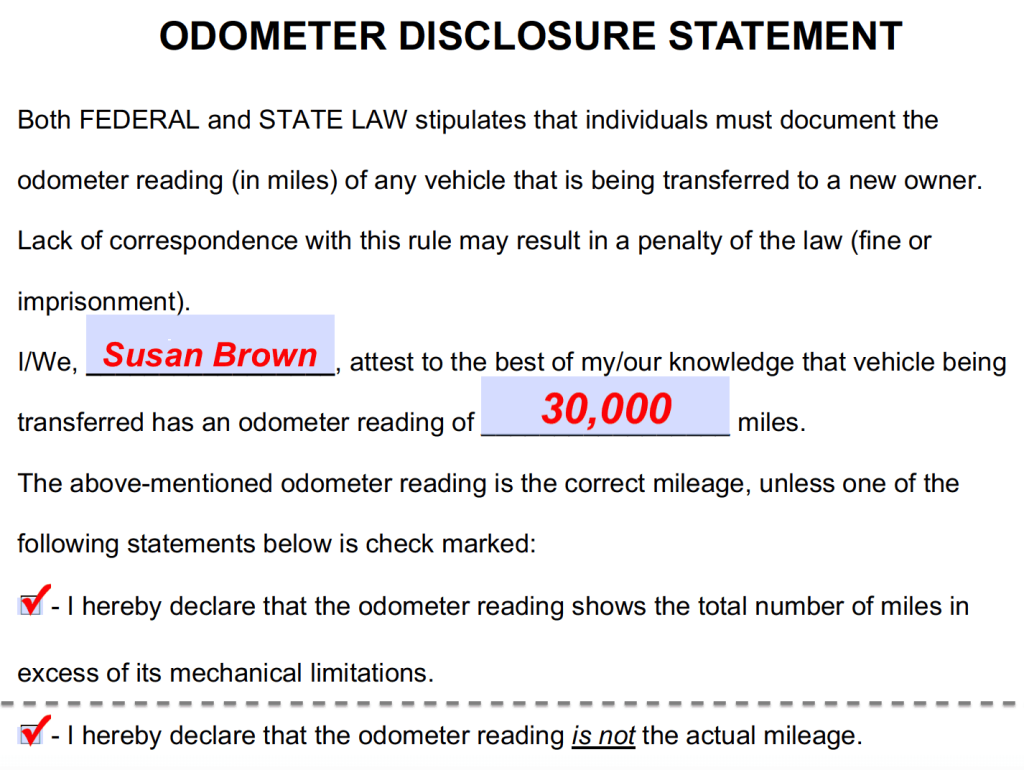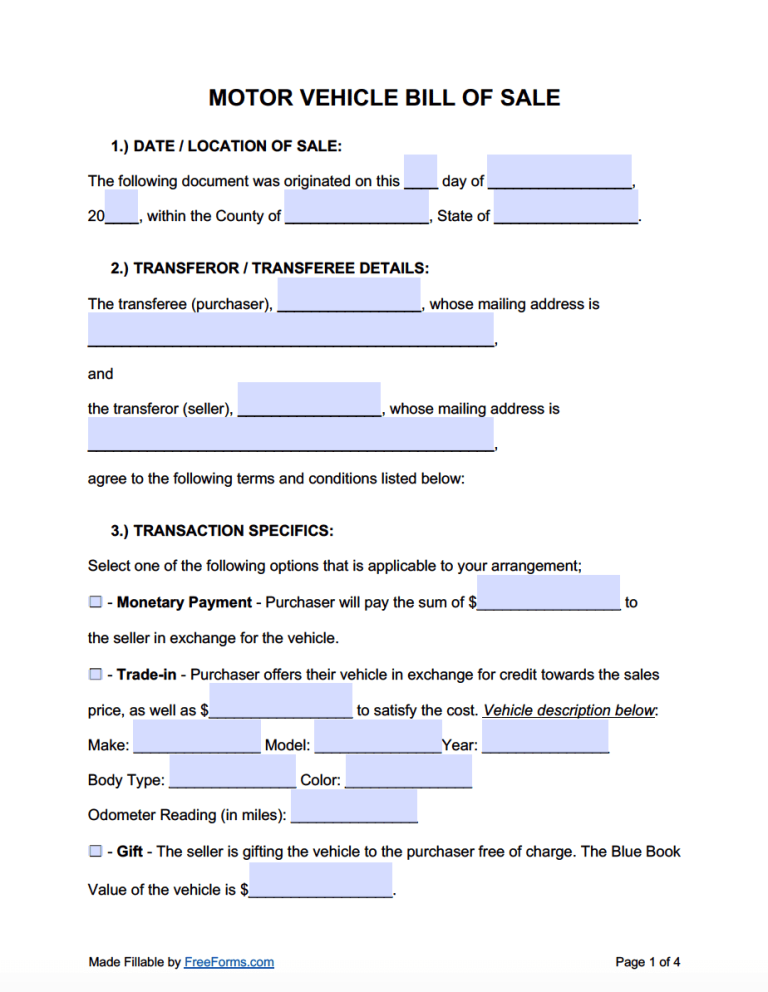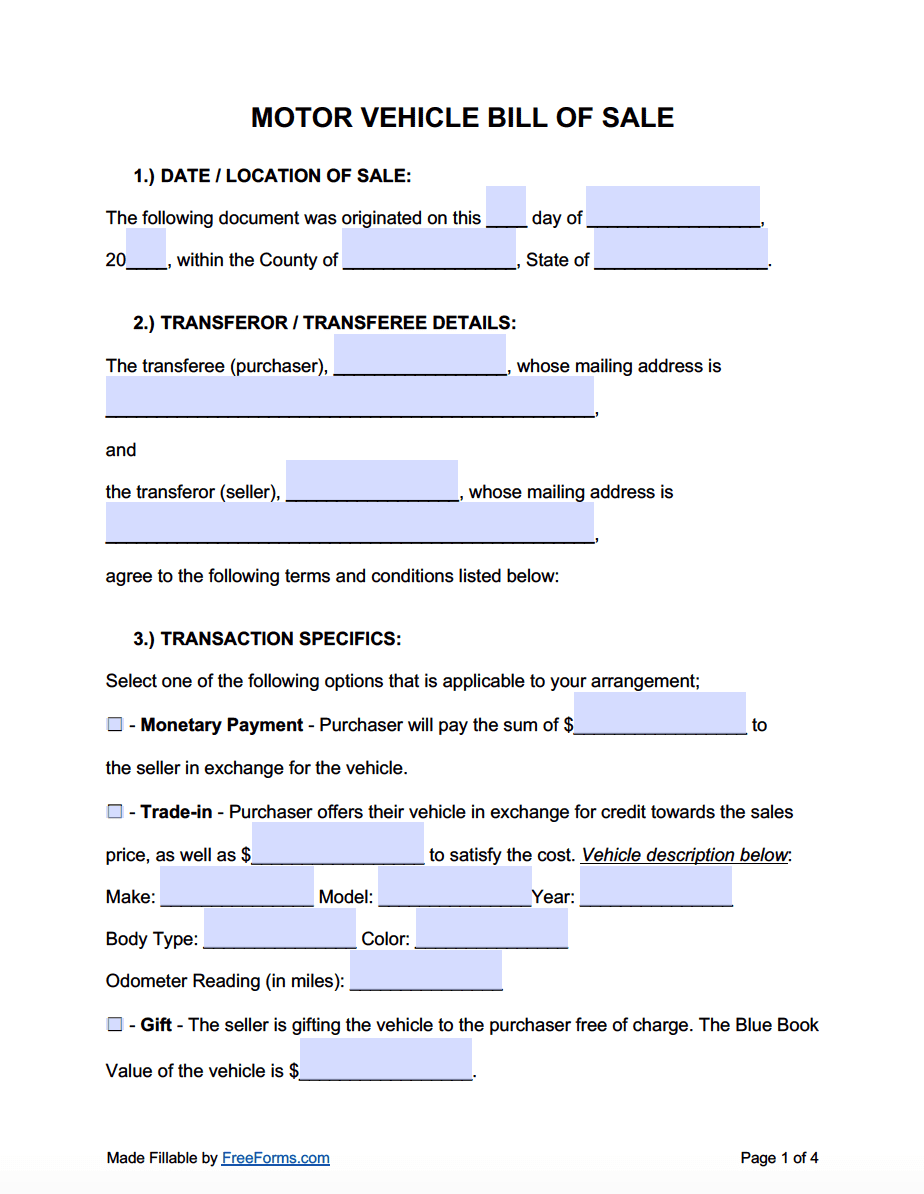By State
- Alabama
- Alaska
- Arizona
- Arkansas
- California
- Colorado
- Connecticut
- Delaware
- Florida
- Georgia
- Hawaii
- Idaho
- Illinois
- Indiana
- Iowa
- Kansas
- Kentucky
- Louisiana
- Maine
- Maryland
- Massachusetts
- Michigan
- Minnesota
- Mississippi
- Missouri
- Montana
- Nebraska
- Nevada
- New Hampshire
- New Jersey
- New Mexico
- New York
- North Carolina
- North Dakota
- Ohio
- Oklahoma
- Oregon
- Pennsylvania
- Rhode Island
- South Carolina
- South Dakota
- Tennessee
- Texas
- Utah
- Vermont
- Virginia
- Washington
- West Virginia
- Wisconsin
- Wyoming
By Type
- Aircraft / Airplane
- As Is
- ATV
- Boat (Vessel)
- Business
- Cat / Kitten
- Dog / Puppy
- Equipment
- Firearm (Gun)
- Horse
- Jet Ski
- Livestock (Animal)
- Mobile Home
- Motor Vehicle
- Motorcycle
- Notarized
- Personal
- RV
- Tractor
- Trailer
What is a Bill of Sale Most Commonly Used For?
A bill of sale is most frequently deployed for the purchase and sale of a motor vehicle. That being said, most states still require that the previous owner sign-over the vehicle’s title to the buyer, but the bill of sale can provide additional information regarding how the exchange transpired. Think of it as a receipt that may be referred back to in the event that there is ever a legal dispute or you need to supply evidence for tax reasons.
How to Privately Sell or Purchase a Motor Vehicle
There is a certain protocol that must be followed when selling or buying a vehicle during a private sale. A key component of that is the execution of a motor vehicle bill of sale. Below are a series of steps designed to guide you through the process.
Step 1 – Establish the Terms of the Agreement

Assuming the buyer and seller have come in contact with one another either through an ad or by word of mouth, both parties must discuss the terms and conditions of how the transaction will transpire. Specifics such as the price of the vehicle, method of payment, and what extras are included (if any) should all be negotiated prior to the signing.
Step 2 – Acquiring the VIN (Vehicle Identification Number)

Every vehicle contains a unique 17-digit code called a “Vehicle Identification Number”. It is typically found on the driver’s side dash but can be located in other areas of the vehicle as well. The buyer should ask the seller to provide the VIN in order to check the vehicle’s history. There are several sites where you can supply the VIN and receive a full vehicle history report. Some of the more popular sites include:
- CarFax.com – View the full vehicle history report for a fee of $39.99 (other deals are offered based on the number of reports you desire).
- AutoCheck.com – Purchase a single report for $24.99.
- VINCheckPro.com – One premium vehicle history report priced at $6.95 (less extensive report than previously mentioned sites).
A vehicle history report will only include information that was recorded by insurance companies, DMV’s, police departments, and mechanics. If an incident was not brought to the attention of one of the aforementioned, it will not appear on the report. To ensure that there are no hidden defects within the vehicle, a pre-purchase inspection by a mechanic of the buyer’s choice can be considered a good measure before completing the transaction.
Step 3 – Collecting the Vehicle’s Documentation
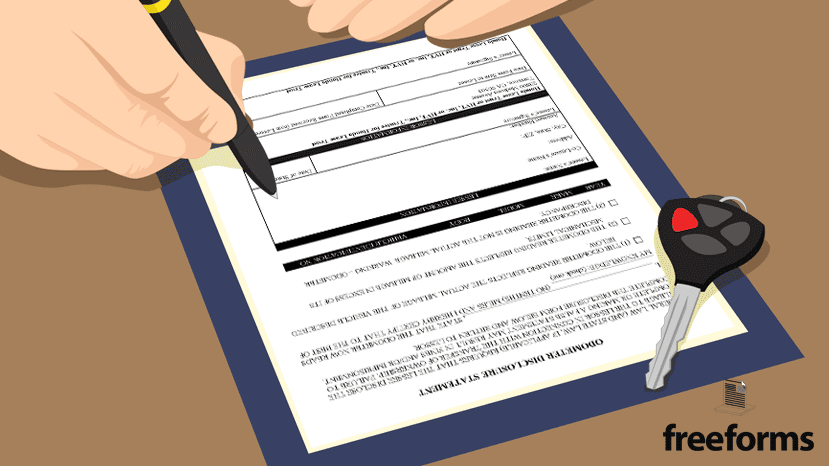
It is important that the seller collects all the vital paperwork regarding the vehicle in order to give it to the new owner. Such paperwork includes:
Certificate of Title – This is considered the most important document when it comes to the transfer of ownership. It contains specific information pertaining to the vehicle and allows the seller to sign over their rights of possession.
Vehicle Registration – To operate a vehicle on public roadways, it is essential that you register the vehicle with the state in which you reside. When you do so, you are given a piece of paper proving that the vehicle is registered. You must provide the buyer with the registration upon transfer of ownership.
- Example – California Vehicle Registration
Bill of Sale – Once the buyer and seller have agreed upon the terms of the transaction, it is highly recommended to carry out a bill of sale. This form records specific sale information and typically requires that both parties sign and date the document. It may not be required in every state but is still considered commonplace as it works as a receipt of the transaction.
- Download in Adobe PDF.
Odometer Disclosure Statement – Whenever there is a transfer of ownership in regards to a motor vehicle, it is legally required for the seller to disclose the odometer reading of the vehicle. In some states, you can record this information to the title or within the bill of sale, in others, you are responsible to complete and sign an Odometer Disclosure Statement. This form will inquire certain details concerning the mileage and mandates that both parties sign the document.
- Download in Adobe PDF.
Proof of Identity – When purchasing a used vehicle in a private sale, it is important for the buyer to request a valid form of ID from the seller to guarantee that they are indeed the rightful owner. A driver’s license, state issued ID, or passport should be sufficient evidence to dispell any suspicion of fraudulent activity. (Be sure to match the name listed on the ID to the name recorded on the title/registration.)
Step 4 – Finalizing the Transaction

Now that both parties have come to an agreement and are satisfied with the preliminary measures, it is time to execute the transaction. The seller and buyer should meet at an agreed upon location and do the following actions:
- Sign the Necessary Paperwork – The seller must provide the signed-over title and a completed bill of sale. The bill of sale will then be signed by both individuals and a copy may be distributed to each party.
- Collect Payment – The buyer must provide the form of payment that was agreed upon prior to the closing. Once the seller receives the payment, they may present the new owner with the vehicle’s keys to conclude the transaction. (Sales tax must be paid to the DMV during the transfer of title and registration.)
Step 5 – Registering your Recently Purchased Vehicle
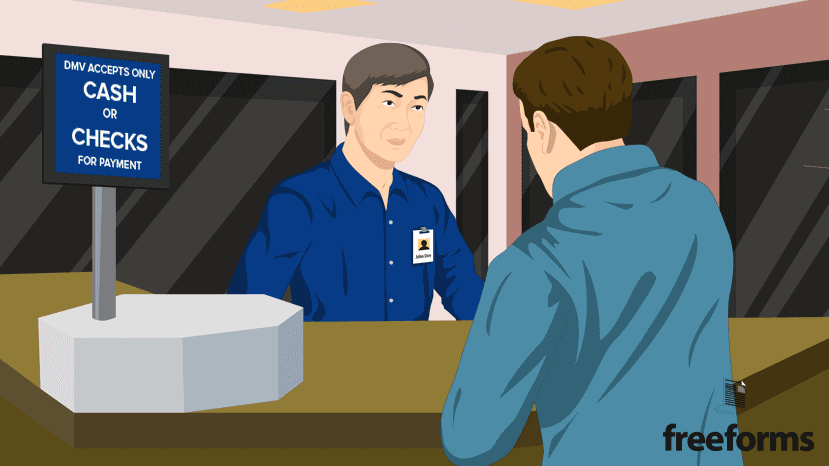
The new owner must now bring the vehicle in for registration. You are typically allotted a certain period of time from the date of sale to register your vehicle. Visit your local vehicle registration office and be prepared with the following documentation (requisites vary from state to state):
- Bill of Sale – Completed and signed by both the seller and buyer.
- Certificate of Title – The original title signed by the previous owner.
- Proof of Auto Insurance – The individual registering must furnish evidence of an active car insurance policy in his or her name.
- Photo ID – Be prepared to present a valid form of photo identification (driver’s license, state ID, passport, etc.)
- Odometer Disclosure Statement – Required in certain states, otherwise record the mileage on title or bill of sale.
- Emissions Test – Only if it legally required within the state you live.
- Payment – Bring the necessary funds to appease any fees associated with registration, titling, and/or taxes.
DMV Locations by State
| State | DMV Office Locations & Hours | Is a Bill of Sale Legally Required? | Motor Vehicle Bill of Sale Download |
|---|---|---|---|
| Alabama | Vehicle Registration Offices | Yes, if there is no title available. | Adobe PDF |
| Alaska | DMV (Division of Motor Vehicles) Office Locations | No | Adobe PDF |
| Arizona | MVD (Motor Vehicle Services) Locations | No | Adobe PDF |
| Arkansas | OMV (Office of Motor Vehicles) Locations | Yes, if the seller would like to apply for a sales tax credit or if there is no space for the seller to provide a signature on the title. | Adobe PDF |
| California | DMV (Department of Motor Vehicles) Locations | No | Adobe PDF |
| Colorado | DMV (Department of Motor Vehicles) Locations | Yes, if the buyer would like to operate the vehicle prior to registration or if there is no room to record the mileage on the title. | Adobe PDF |
| Connecticut | DMV (Department of Motor Vehicles) Locations | Yes | Adobe PDF |
| Delaware | DMV (Division of Motor Vehicles) Locations | Yes, under certain circumstances a bill of sale may be required. | Adobe PDF |
| Florida | DHSMV (Department of Highway Safety and Motor Vehicles) Locations | Yes | Adobe PDF |
| Georgia | County Tag Office Locations | No | Adobe PDF |
| Hawaii | Hawaii Department of Transportation Locations | Yes, if the individual selling the vehicle is not listed on the title. | Adobe PDF |
| Idaho | DMV (Department of Motor Vehicles) Locations | Yes, if there is no room to input the sales price on the title. | Adobe PDF |
| Illinois | SOS (Secretary of State) Facility Locations | No | Adobe PDF |
| Indiana | BMV (Bureau of Motor Vehicles) Office Locations | Yes, if the title is unobtainable, a bill of sale must be completed, signed by both parties, and notarized. | Adobe PDF |
| Iowa | County Treasurers Office Locations | No | Adobe PDF |
| Kansas | DOV (Division of Vehicles) Locations | Yes, if there is no available space on the title to input the names and signatures of the parties involved or the purchase price. | Adobe PDF |
| Kentucky | County Clerks Office Locations | No | Adobe PDF |
| Louisiana | OMV (Office of Motor Vehicles) | Yes, if the title does not contain pertinent info such as the sales date/price or signatures of the parties involved. | Adobe PDF |
| Maine | BMV (Bureau of Motor Vehicles) Locations | Yes | Adobe PDF |
| Maryland | MVA (Motor Vehicle Administration) Locations | Yes | Adobe PDF |
| Massachusetts | RMV (Registry of Motor Vehicles) Locations | Yes, if there is no title available or if the vehicle is exempt from titling, a bill of sale and the last registration will suffice. | Adobe PDF |
| Michigan | SOS (Secretary of State) Office Locations | No | Adobe PDF |
| Minnesota | DVS (Driver and Vehicle Services) Locations | No | Adobe PDF |
| Mississippi | Tax Collectors Office Locations | Yes, if there is no available space to insert the sales price on the title. | Adobe PDF |
| Missouri | DOR (Department of Revenue) Locations | Yes | Adobe PDF |
| Montana | County Treasurer’s Office Locations | Yes, only in the absence of a title, in which case, you would have to provide a bill of sale as well as an Application for Replacement Certificate of Title (Form MV7). | Adobe PDF |
| Nebraska | County Treasurer’s Office Locations | No | Adobe PDF |
| Nevada | Nevada DMV (Department of Motor Vehicles) Locations | Yes, a bill of sale is necessary if there is no title and the vehicle is at least 9 years old with no active liens. | Adobe PDF |
| New Hampshire | DMV (Department of Motor Vehicles) Locations | No | Adobe PDF |
| New Jersey | MVC (Motor Vehicle Commission) Locations | Yes, if the title is missing. | Adobe PDF |
| New Mexico | MVD (Motor Vehicle Division) Locations | Yes, when the certificate of title is unavailable. | Adobe PDF |
| New York | DMV (Department of Motor Vehicles) Locations | Yes | Adobe PDF |
| North Carolina | County Tax Office Locations | No, only required when purchased from a dealership. | Adobe PDF |
| North Dakota | DOT (Department of Transportation) Locations | No | Adobe PDF |
| Ohio | BMV (Bureau of Motor Vehicles) Locations | No, only if the vehicle was acquired in another state or if it was imported from another country. | Adobe PDF |
| Oklahoma | Tax Commission Office Locations | No | Adobe PDF |
| Oregon | DOT (Department of Transportation) Locations | Yes | Adobe PDF |
| Pennsylvania | DOT (Department of Transportation) Locations | No | Adobe PDF |
| Rhode Island | DMV (Division of Motor Vehicles) Locations | Yes | Adobe PDF |
| South Carolina | DMV (Department of Motor Vehicles) Locations | Yes, if there is no area to note the sales price or mileage on the title, or if the vehicle was titled prior to 06/19/1989. | Adobe PDF |
| South Dakota | County Treasurer’s Office Locations | No, only if the vehicle was purchased in a different state. | Adobe PDF |
| Tennessee | County Clerk’s Office Locations | No | Adobe PDF |
| Texas | County Tax Office Locations | No | Adobe PDF |
| Utah | DMV (Division of Motor Vehicles) Locations | Yes | Adobe PDF |
| Vermont | DMV (Department of Motor Vehicles) Locations | Yes | Adobe PDF |
| Virginia | DMV (Department of Motor Vehicles) Locations | No | Adobe PDF |
| Washington | DOL (Department of Licensing) Locations | Yes | Adobe PDF |
| West Virginia | DMV (Division of Motor Vehicles) Locations | Yes, if the vehicle was purchased for 50% less than its “NADA Clean Loan Book” value, otherwise, it will be taxed according to its full value. | Adobe PDF |
| Wisconsin | DOT (Department of Transportation) Locations | No | Adobe PDF |
| Wyoming | County Treasurer’s Office Locations | Yes | Adobe PDF |
Defining the Terminology
When creating a bill of sale document, you must know the terms that are being used within the agreement. Listed below are the common words/phrases associated with the bill of sale form:
- Seller (Transferor) – Person(s) releasing their rights and transferring ownership of the property to the buyer.
- Buyer/Purchaser (Transferee) – Individual(s) who is buying the property and obtaining the title from the seller.
- VIN (Vehicle Identification Number) – Is a sequence of 17 numbers and letters that can identify a specific vehicle. Every vehicle contains its own unique VIN that can determine the automobile’s characteristics, manufacturer, history, and other important details. (The location of the VIN varies depending on the vehicle.)
- As Is – This term indicates the vehicle is being purchased in its present condition and the buyer accepts any defects the property may have. By incorporating this into the bill of sale, the seller protects themselves from any claims of not disclosing pertinent information involving damages to the property.
- Gift – If the property is being transferred free of charge, it is being gifted.
- Sum of (In the consideration of) – This phrase indicates what price the property is being sold for.
- Notary Public – Is a public official who is authorized to review and certify specific legal documents.
- Trade-in – Is a practice involving the exchange of property towards another piece of property. This can be an equal exchange or partially go towards the price of the desired property. (Typically executed in the automobile industry.)
Frequently Asked Questions (FAQ)
Is a Bill of Sale legally required to sell or purchase a motor vehicle?
It all depends on which state the transaction is taking place in. Some states stipulate that it is mandatory to execute a bill of sale, whereas others do not. However, it is always a good idea to fulfill this agreement regardless as it can be a worthwhile document to have on file.
Who should be supplying the Bill of Sale?
Traditionally, the seller would supply the form upon the exchange of property. That being said, it would be wise for the buyer to bring their own copy in case the seller forgot to bring one or they are not interested in completing the agreement for their own personal records.
Do both parties need to sign the document?
The majority of the bill of sale forms require the signatures of all participating individuals. Some states may only require the signature of the seller. It is recommended that both sides of the transaction sign the document if given the option.
Does the Bill of Sale have to be notarized?
Once again, this varies from state to state. Certain states request that the individuals taking part in the sale of an automobile sign the form while under the review of a notary public who may then ratify the contract. Even if a state does not enforce this rule, you may want to consider achieving this as it increases the validity of the document.
How to Write
Step 1 – Download the document in Adobe PDF or Microsoft Word (.docx).
Step 2 – Sale and Buyer/Seller Information – The first 2 sections of the form require that the participants insert the specified details regarding when and where the transaction is taking place and who is involved in the exchange. Fill in the blank spaces as followed:
- Date of the Transaction:
- Enter the day, month, and last 2 digits of the year within the corresponding spaces.
- Location of the Sale:
- Insert the name of the county and state in which the exchange is to occur.
- Transferor/Transferee Contact Info:
- Provide the names and mailing addresses of both parties (seller & purchaser) involved in the transfer of property.
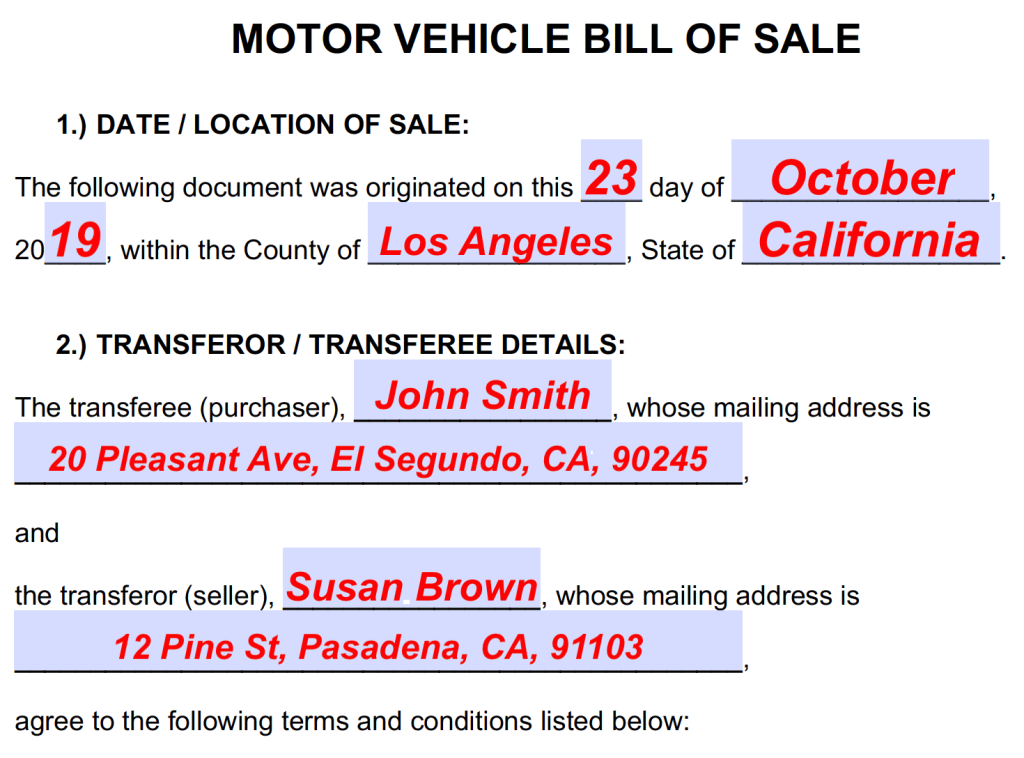
Step 3 – Transaction Specifics – The third section requests that you define the terms of the exchange. There are 3 available options:
- Monetary Payment:
- This is the most common selection where the purchaser provides the necessary funds to cover the full cost of the vehicle. Enter the dollar amount of the purchase price within the designated area. (To avoid any type of fraud, it is suggested that the buyer and seller meet at an agreed-upon bank to transfer the money.)
- Trade-in:
- If the seller agrees, the purchaser may transfer ownership of their vehicle in exchange for credit towards the sales price of the primary vehicle. Check the box and enter the additional dollar amount of money needed to cover the full selling price. Then, fill in the following required fields regarding the trade-in vehicle:
- Make
- Model
- Year
- Body Type
- Color
- Odometer Reading (in miles)
- If the seller agrees, the purchaser may transfer ownership of their vehicle in exchange for credit towards the sales price of the primary vehicle. Check the box and enter the additional dollar amount of money needed to cover the full selling price. Then, fill in the following required fields regarding the trade-in vehicle:
- Gift:
- If the seller would like to transfer possession of the vehicle at no cost to the purchaser, check the indicated box and input the estimated value of the vehicle into the appropriate space.
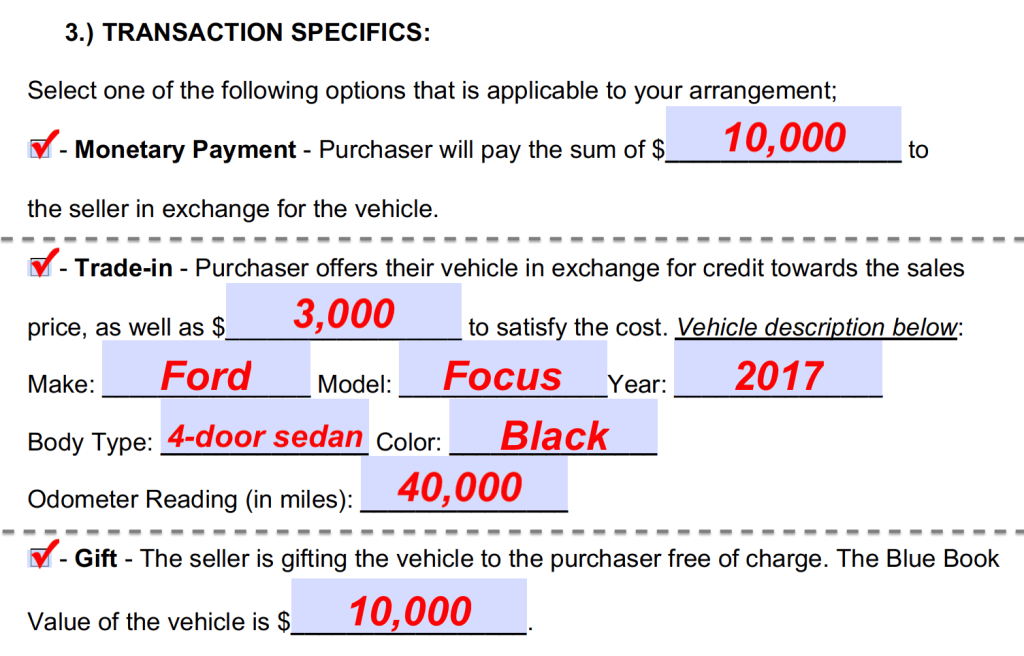
Step 4 – Vehicle Description – Participants must identify the primary motor vehicle that is being transferred to the purchaser. To do so, navigate your way to section 4 of the bill of sale and insert the following details into the proper fields:
- Make
- Model
- Year
- Body Type
- Color
- Odometer Reading (in miles)
- VIN (Vehicle Identification Number)
- Check the first box if all the necessary taxes are included within the vehicle’s sales price.
- Check the second box if no taxes are included within the sales price.
- If applicable, insert any additional provisions regarding the exchange within the designated section.
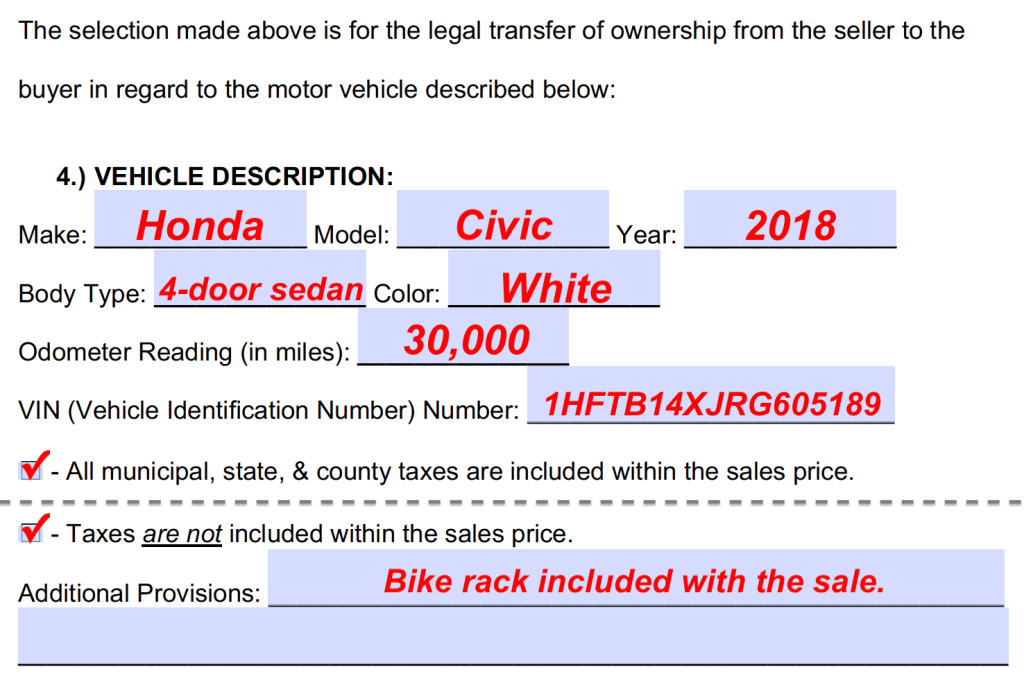
Step 5 – Acknowledgment of Notary Public – Before the parties sign the document in the designated section, it is advised that all signatures be performed while under the review of a notary public. Even though some states may not require this action, it can be considered a good measure to take in order to strengthen the legitimacy of the agreement. The official possessing notarial power must complete the 2 assigned sections (one for the seller and one for the buyer) by filling in the following blanks:
- State in which the agreement is being certified.
- County
- Date (day, month, year)
- Name of the Seller/Buyer
- Notary Signature
- Date in which their commission expires.
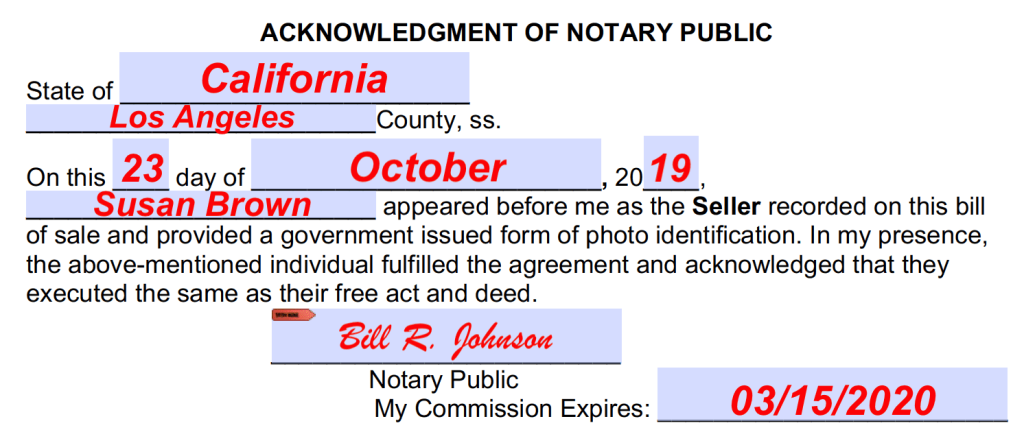
Step 6 – Odometer Disclosure Statement – The last portion contained within the bill of sale is the “Odometer Disclosure Statement”. Here, the seller must provide the current mileage displayed on the vehicle’s odometer. Failure to do so or providing a false reading could result in a fine or even imprisonment. Enter the following information as follows:
- Name of the Seller(s)
- Mileage
- Check the first box if the seller declares that the odometer reading shows the total mileage in excess of its mechanical limitations.
- Check the second box if the seller declares that the odometer reading listed above is not the actual mileage.
After submitting the information above, both parties should provide their signatures and printed names on the proper lines below.
